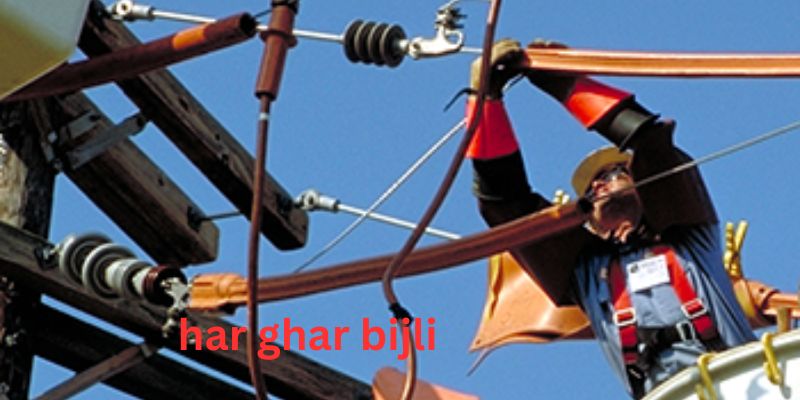Introduction: Har Ghar Bijli
Electricity is more than just an amenity—it’s a lifeline. In rapidly evolving India, dependable power supply can transform education, healthcare, entrepreneurship, and quality of life. The Har Ghar Bijli initiative (also known as the Saubhagya Yojana) strives to electrify every Indian household. This article delves into its inception, execution, successes, hurdles, and future potential.
Table of Contents
What Is Har Ghar Bijli?
Definition and Aim
Har Ghar Bijli, launched in September 2017, is a flagship scheme of the Central Government with the goal of ensuring electrification of all willing households—with an emphasis on remote and underprivileged areas. It provides free power connections to families living below the poverty line.
Importance of Universal Access
Access to electricity is indispensable: it supports evening studies, healthcare services, income generation, and women’s safety. Moreover, it helps India transition toward sustainable development.
How the Program Works
Mapping and Surveys
Local authorities conducted door-to-door surveys to locate unelectrified homes. This data was compiled and verified through a centralized portal, ensuring no household was overlooked.
Distribution Company (DISCOM) Partnerships
Program execution relies on close coordination between the Ministry of Power, state governments, and DISCOMs. Financial grants help fund grid expansion and infrastructure development.
Infrastructure and Technology
- Grid extensions reached accessible villages.
- Off-grid solutions like solar panels were used for isolated areas.
- A monitoring portal tracks installation progress.
- Grievance systems and helplines ensure quick issue resolution.
Finances
With a budget of nearly ₹16,320 crore, the scheme is jointly funded by the Center and states, prioritizing poor households with no prior setup.
Notable Achievements
Village and Household Electrification
By March 2019, villages across India were officially electrified, and more than 2.8 crore households received power. States such as Bihar, Uttar Pradesh, Assam, and Odisha reached full electrification milestones.
Societal Benefits
Better Learning Conditions
Evening homework is no longer hindered by inadequate lighting, improving academic outcomes.
Enhanced Healthcare
Rural health centers now operate modern medical equipment, maintain vaccine refrigeration, and extend operational hours.
Empowering Women
Electricity reduces reliance on kerosene, decreases indoor pollution, and provides safer environments after dusk.
Economic Growth
Rural entrepreneurs—like grocery shops and small artisans—can now operate more efficiently and profitably.
Real-World Impact: Stories from the Field
Case Study: Bihar’s Transformation
Once lagging, Bihar now reports universal household electrification. Residents note extended shop hours and late-night study sessions as major improvements.
Himalayan and Northeastern Reach
Even high-altitude and remote tribal hamlets are now connected, often via solar grids, that overcome challenging terrain and weather obstacles.
Empowering Adivasi Communities
In forested regions of Chhattisgarh and Odisha, solar-powered panels and mini-grids ensure energy access without harming the environment.
Persistent Challenges
Ensuring Connection Quality
While access is widespread, the reliability and consistency of electricity supply in many regions remains problematic.
Maintaining Infrastructure
Equipment failures—broken meters, poor wiring, transformer malfunctions—can disrupt service, requiring sustained upkeep.
Geographic Hurdles
Grid expansion into deep forests or mountainous regions is expensive and administratively complex.
Awareness and Digital Literacy
Rural and tribal communities may struggle to report issues or navigate digital grievance portals, limiting the scheme’s efficacy.
Evolving Measures and Future Plans
Real-Time Monitoring
Electronic dashboards track progress and flag delays. Customer service channels ensure prompt resolution.
Toward 24×7 Power
After initial electrification, focus has shifted to providing continuous, high-quality power for all households, farms, and businesses.
Embracing Renewables
Hybrid models—combining solar with battery backup—ensure energy security in off-grid areas.
Smart Grid Technologies
Pilot projects include smart meters, prepaid billing, and automation for system optimization and transparency.
Complementary Schemes
Har Ghar Bijli aligns with several other initiatives:
- UJALA: Distributes LED bulbs to reduce energy use.
- DDUGJY: Enhances rural transmission and distribution systems.
- KUSUM: Enables farmers to install solar pumps for irrigation.
Together, these accelerate rural electrification, sustainability, and self-reliance.
Criticisms & Areas for Growth
Discrepancy in Numbers
While official data claims near-total electrification, independent surveys indicate some families still lack stable connections.
- Some beneficiaries never received meter installations.
- Others lost connectivity due to component damage.
Inclusion Issues
Migrants and nomadic populations may fall through the cracks due to lack of formal documentation or permanent addresses.
Local Community Engagement
Rural communities and local bodies need more roles in managing and maintaining infrastructure for better ownership and resilience.
Looking Ahead: The Road to Sustainable Energy
Expanding Renewable Integration
As solar energy and microgrids become more affordable, further electrification can bypass traditional infrastructure—especially in remote regions.
Strengthening Grid Infrastructure
Ongoing investment in transmission lines, transformers, and maintenance is crucial to reliable service.
Digital Empowerment
Literacy programs and accessible platforms can help households more effectively use and manage their electricity connections.
Skill Development
Local villages can develop teams trained in technical repair and system upkeep, improving both employment and service continuity.
Conclusion
The Har Ghar Bijli initiative is a landmark step toward equitable energy access in India. It marks a significant leap in connecting millions of households to modern amenities. While challenges persist—particularly around reliability, maintenance, and full community inclusion—the achievements so far are transformative.
Moving forward, sustaining and building upon this progress involves weaving together grid upgrades, renewable energy, smart technologies, and community empowerment. If realized fully, Har Ghar Bijli will not just bring light into homes—it will illuminate the future of rural India.










